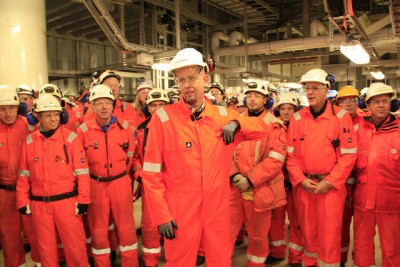After another week of low oil prices and rising unemployment, Oil Minister Tord Lien was grasping for bright spots in the industry he oversees. He finally found one on Friday, and claims he’s still optimistic about oil’s long-term future.

Lien has made it clear that he remains bullish on prospects for the largest and most important sector of Norway’s economy. “Even if the most pessimistic forecasts are realized, the oil business will continue to employ around 200,000 people in Norway,” he told newspaper Aftenposten recently. He conceded that the current slowdown caused by the rapid decline in oil prices is “no doubt a crisis” for those “who have to leave what they’d seen as secure jobs,” and that the situation is “more demanding” for some parts of the industry than others.
“But fortunately, there are many who can recall (earlier) periods when declines were steep,” Lien said. “We know that the industry has come through them, and come back stronger every single time. I’m confident that will happen this time, too.”
Sverdrup to the rescue
On Friday, Lien seemed all but vindicated when analysts at ABG Sundal Collier and Rystad Energy declared that Statoil’s huge new Johan Sverdrup oil field off Stavanger can be profitable even with an oil price down at USD 30 a barrel. He was further cheered when the price of Norway’s North Sea crude rose a bit, from lows around USD 43 earlier in the week to just over USD 45 towards week’s end.
Newspaper Dagens Næringsliv (DN) reported that, according to Rystad, the Sverdrup field will benefit from corresponding reductions in the cost of development, drilling and maintenance. Sverdrup, Norway’s biggest oil discovery since the 1980s, had needed an oil price of USD 41 to earn a profit before the projected decline in its investment costs. Espen Erlingsen, senior analyst at Rystad, called Sverdrup a “secure project” and “one of the best oil fields in the world.”
Analyst John A Olaisen at ABG Sundal Collier agreed, saying he’d be “surprised” if investment costs that initially were expected to be around NOK 117 billion don’t decline to NOK 100 billion.” That would spur profitability at USD 30 a barrel for oil, and few analysts think prices will fall that far when the field starts producing oil in 2019.
Sverdrup plan approved
Lien, from the conservative Progress Party, has been raving about Sverdrup since he assumed his ministerial role two years ago. On Thursday his ministry formally approved plans for the first construction phase of the project among partners who have quarreled earlier. The field’s development, he said, “will have enormous impact for employment and activity” on the offshore field itself and for oil supply businesses on the mainland. Lien clearly see Sverdrup as a saving grace in an otherwise battered industry that he hopes will quickly turn around again when oil prices climb again anywhere from one to three years from now.
Meanwhile, Lien maintains that “we have to roll up our sleeves and bring costs down, work smarter and develope and take into use new technology.” While others are clamouring for far more emphasis on develop of non-oil-related activity, Lien has also controversially claimed that he will “do all I can” to set the stage for more oil exploration and production off the scenic northern coast of Lofote and Vesterålen.
“We have to show that there are attractive business opportunities for the industry in both the short and long term,” Lien told Aftenposten. “Lofoten and Vesterålen are attractive areas that don’t lie far from land, are closer to infrastructure and in relatively shallow water.” He claimed that “the most important thing” the government can do is to provide a “stable and predictable” framework for the oil business, to restore and create jobs.
newsinenglish.no/Nina Berglund

